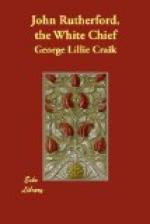The Baron de Humboldt, too, informs us that the Indians of Guiana sometimes imitate, in the oddest manner, the clothes of Europeans in painting their skin. This observant traveller was much amused by seeing the body of a native painted to represent a blue jacket and black buttons. The missionaries also told him that the people of the Rio Caura paint themselves of a red ground, and then variegate the colour with transverse stripes of silver mica, so that they look most gallantly dressed. The painted cheeks that were once common in Europe, and are still occasionally seen, are relics of the same barbarism.
The “taboo,” or “tapu,” prevails also in many of the South Sea Islands, where it may be considered as the substitute for law; although its authority, in reality, rests on what we should rather call religious considerations, inasmuch as it appears to be obeyed entirely from the apprehension that its violation would bring down the anger of heaven.
It would require more space than we can afford to enumerate the various cases in which the “taboo” operates as a matter of course, even were we to say nothing of the numerous exigencies in which a resort to it seems to be at the option of the parties concerned. Among the former, we may merely mention that a person supposed to be dying seems to be uniformly placed under the “taboo”; and that the like consecration, if it may be so called, is always imposed for a certain space upon the individual who has undergone any part of the process of tattooing. But we are by no means fully informed either as to the exact rules that govern this matter, or even as to the peculiar description of persons to whom it belongs, on any occasion, to impose the “taboo.” It is common in New Zealand for such of the chiefs as possess this power to separate, by means of the “taboo,” any thing which they wish either to appropriate to themselves, or to protect, with any other object, from indiscriminate use.
When Tetoro was shown, in the “Dromedary,” a double-barrelled fowling-piece, belonging to one of the officers, he “tabooed” it by tying a thread, pulled out of his cloak, round the guard of the trigger, and said that it must be his when he got to New Zealand, and that the owner should have thirty of his finest mats for it. But this, according to Cruise, any native may do with regard to an article for which he has bargained, in order to secure it till he has paid the price agreed upon.
On another occasion, Cruise found a number of people collected round an object which seemed to attract general attention, and which they told him was “tabooed.” It turned out to be a plant of the common English pea, which was fenced round with little sticks, and had apparently been tended with very anxious care.
When the “Prince Regent” schooner, which accompanied the “Dromedary,” lay at anchor in the river Shukehanga,[Y] a chief named Moodooi,[Z] greatly to the comfort of the captain, came one day on deck and “tabooed” the vessel, or made it a crime for any one to ascend the side without permission, which injunction was strictly attended to by the natives during his stay in the harbour.




